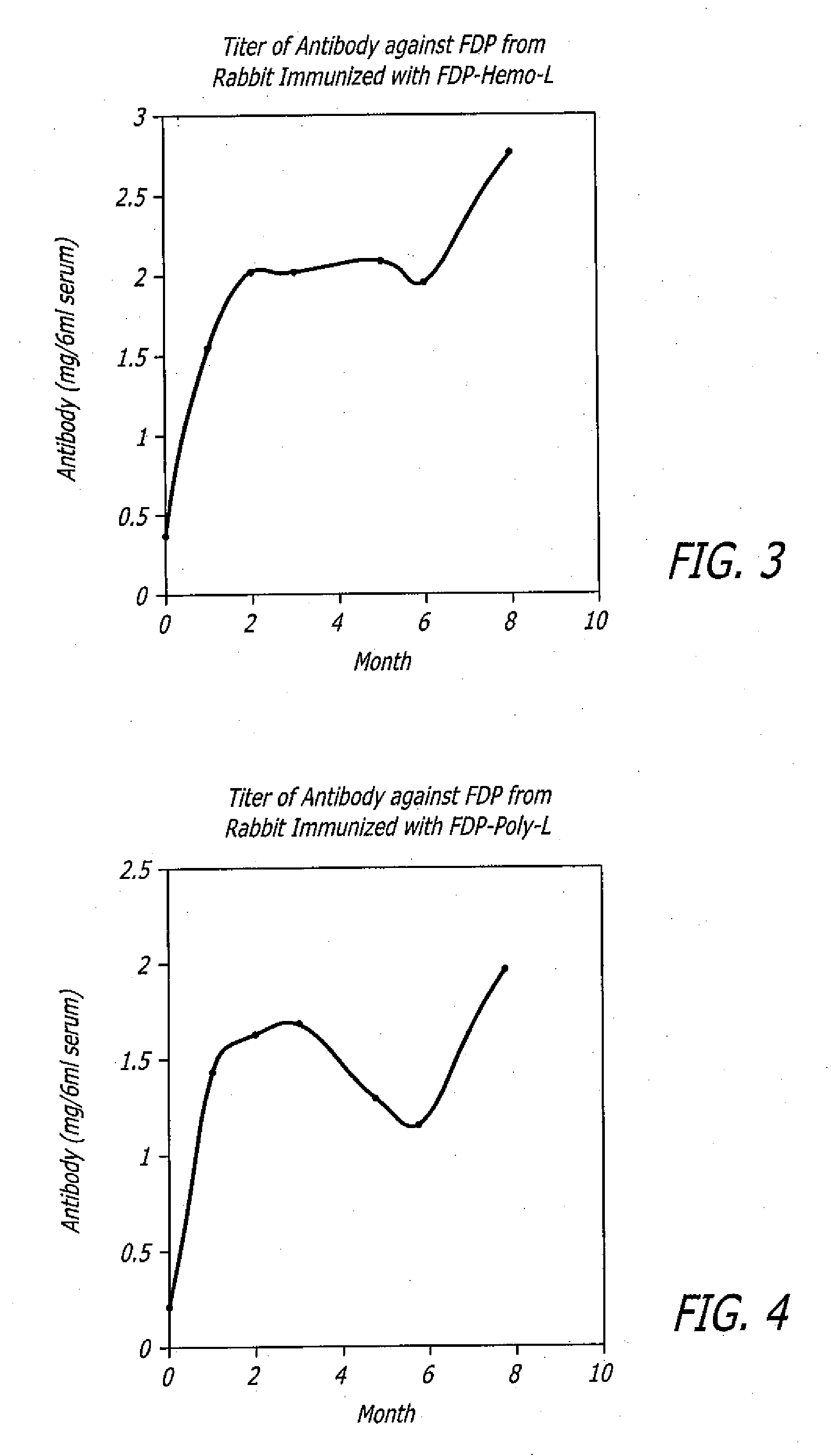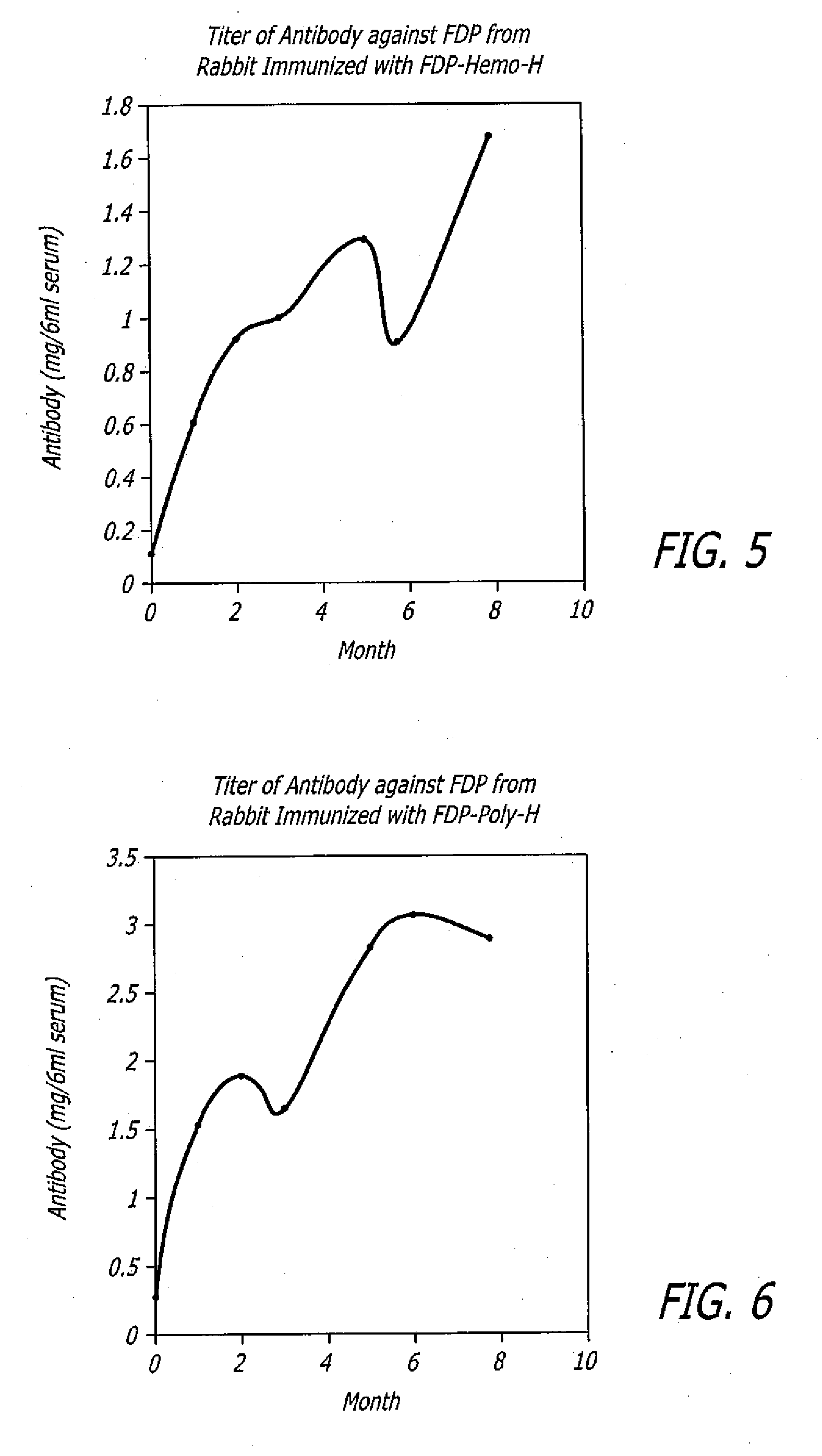Polyclonal antibodies against fibrinogen degradation products and associated methods of production and use
a fibrinogen degradation and polyclonal antibody technology, applied in the field of polyclonal antibodies against fibrinogen degradation products and associated methods of production and use, can solve the problems of false positives or lack of sufficient scope for effective screening of antibody mediated tests, and the existence of cancer in patients, so as to reduce time and effort, increase the production of fdp antibodies
- Summary
- Abstract
- Description
- Claims
- Application Information
AI Technical Summary
Benefits of technology
Problems solved by technology
Method used
Image
Examples
example 1
Preparation of FDP Immunogen
[0069]In one embodiment, FDP was prepared from human fibrinogen. Fibrinogen was digested with human plasma plasmin. Human fibrinogen (139 mg) was dissolved in 20 ml MOPS buffer (MOPS:3-[morpholino]propane sulfonic acid, 50 mM; NaCl, 0.1 M; CaCl, 2 mM) pH 7.4 at 37° C. Plasmin (5 Units in 1 ml DI water) was added to the fibrinogen solution. The solution was continuously shaken at 37° C. for 3 hours. At the end of 3 hours, the solution was removed from 37° C. and placed on ice. Portions of FDP solution were diluted with PBS to 1 mg FDP / ml and were dispensed in 1 ml per vial. The vials were kept frozen until use.
example 2
Preparation of Immunogen Consisting of FDP Coupled to Keyhole Limpet Hemocyanin at Low FDP Concentration (FDP-Hemo-L)
[0070]In another embodiment, FDP-Hemo-L immunogen was prepared by linking keyhole limpet hemocyanin (KLH) to lower concentrations of FDP. FDP (8 mg in 1.2 ml) was mixed with 20 mg KLH in 10 ml 0.2 M TAPS (3-[{Tris(hydroxymethyl)methyl}amino]-1-propanesulfonic acid) buffer pH 8.8. Dimethylsuberimidate (12 mg in 0.6 ml ethanol) was added to the above solution of FDP plus KLH and was allowed to react at room temperature for 2 hours. The solution was then dialyzed 2 times at 4° C. against 2 L PBS each time. The volume of the dialysate was measured and divided into 12 aliquots and stored frozen at −40° C.
example 3
Preparation of immunogen Consisting of FDP Coupled to Keyhole Limpet Hemocyanin at High FDP Concentration (FDP-Hemo-H)
[0071]In another embodiment, FDP-Hemo-H immunogen was prepared by linking keyhole limpet hemocyanin (KLH) to higher concentration of FDP. FDP (25 mg in 3.8 ml) was mixed with 20 mg KLH in 10 ml 0.2 M TAPS (3. [{Tris(hydroxymethyl)methyl}amino]-1-propanesulfonic acid) buffer pH 8.8. Dimethylsuberimidate (DMS, 13 mg in 0.65 ml ethanol) was added to the above solution of FDP plus KLH and was allowed to react at room temperature for 2 hours. The solution was then dialyzed 2 times at 4° C. against 2 L PBS each time. The volume of the dialysate was measured and divided into 12 aliquots and stored frozen at −40° C.
PUM
| Property | Measurement | Unit |
|---|---|---|
| Density | aaaaa | aaaaa |
| Density | aaaaa | aaaaa |
| Density | aaaaa | aaaaa |
Abstract
Description
Claims
Application Information
 Login to View More
Login to View More - R&D
- Intellectual Property
- Life Sciences
- Materials
- Tech Scout
- Unparalleled Data Quality
- Higher Quality Content
- 60% Fewer Hallucinations
Browse by: Latest US Patents, China's latest patents, Technical Efficacy Thesaurus, Application Domain, Technology Topic, Popular Technical Reports.
© 2025 PatSnap. All rights reserved.Legal|Privacy policy|Modern Slavery Act Transparency Statement|Sitemap|About US| Contact US: help@patsnap.com



